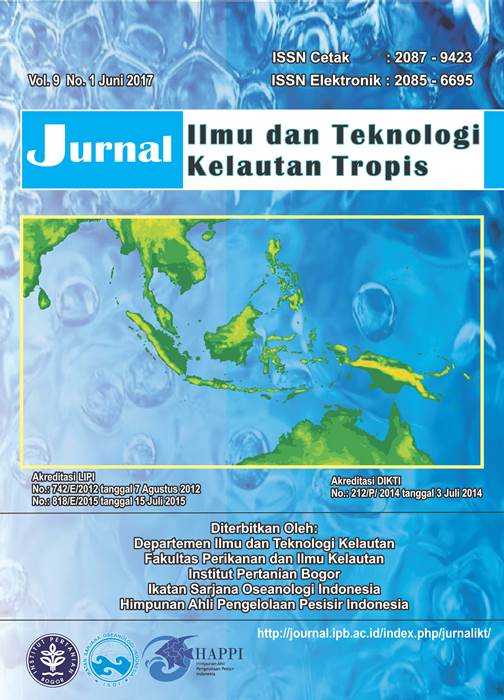SEDIMENT ACCUMULATION PROFILE IN MANGROVE RESTORATION AREA OF LEMBAR BAY-LOMBOK ISLAND
Abstract
Mangrove restoration is really needed for restoring its ecosystem functions, so that it could be able to support fisheries activity and to protect coastal by extreme weather. In addition, mangrove is able to accumulate sediment that important in protecting the coastal area from sea level rise. Therefore, the aim of this study is to investigate sediment accumulation rate in mangrove area during post restoration. Sampling location were divided into three different stations based on estimated restoration ages, such as ≥ 15 years old (Station 1), 4 - 10 years old (Station 2) and 2 - 8 years old (Station 3). Sediment cores were carried out by inserting 7.6 cm diameter and 100 cm length of polyvinyl chloride pipes. Sedimentation rate is measured by using Pb-210 radionuclide analysis. The results show that the sediment accumulation rate in the last 20th years from all station ranges from 0.17 to 0.42 g/cm2/year. The highest accumulation rate is found at oldest year old station while the lowest accumulation rate is found at younger year old station of mangrove restoration area. Restoration process is clearly able to recover the mangrove’s role in trapping sediment in coastal region.
Keywords: sediment accumulation, mangrove restoration, Lembar Bay- Lombok Island
Authors
This work is licensed under a Creative Commons Attribution 4.0 International License.
Jurnal Ilmu dan Teknologi Kelautan Tropis i is an open-access journal, meaning that all content is freely available without charge to the user or their institution. Users are allowed to read, download, copy, distribute, print, search, or link to the full texts of the articles in this journal without needing to request prior permission from the publisher or the author.
All articles published by Jurnal Ilmu dan Teknologi Kelautan Tropis are licensed under the Creative Commons Attribution 4.0 International License. This allows for unrestricted use, distribution, and reproduction in any medium, provided proper credit is given to the original authors.
Authors submitting manuscripts should understand and agree that the copyright of published manuscripts is retained by the authors. Copyright encompasses the exclusive rights of authors to reproduce, distribute, and sell any part of the journal articles in all forms and media. Reproduction of any part of this journal, its storage in databases, and its transmission by any form or media is allowed without written permission from Jurnal Ilmu dan Teknologi Kelautan Tropis.


